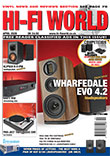March 2012 Issue |
Page 1 of 6 World mail March 2012 issue Write to us! E-mail –> This e-mail address is being protected from spambots. You need JavaScript enabled to view it
Letters are published first in the magazine, then here in our web archive. We cannot guarantee to answer all mail, but we do manage most!
Or comment in the Comment section at the bottom of each page.
Your experts are -
Now audio from computers is being taken seriously such convertor units are "springing up like daises" say Item Audio.
GEEK SPEAK I was pleased to see that you are to do a piece on computer audio. This is a highly confusing area, not least because of the geek-speak used (for an appalling example try “HAL I/O using DAC native physical formats “Integer Mode” (instead of CoreAudio 32bit float)”) but also because we don’t understand what is actually happening to the digits. Nobody I know can even explain how data is read off a simple memory stick. I have music files of various kHz on a Mac laptop and have seen many programmes being touted as better than iTunes - Amarra, VLC, Songbird, Audirvana, Fidelia etc - for sending the signal to the DAC (in my case, the optical input of a Quad CDP2 with variable output into a Quad 909). Why should this be? It’s ‘only’ a sequence of noughts and ones. It would be useful to do a group review and explanation of what these programmes do and don’t do, for both Mac and PC users. Another topic so-far resistant to explanation concerns the use of mid-stream gadgets like the V-LINK which make the signal asynchronous (‘out of time’ according to my dictionary). I read somewhere that up-sampling DACs like the Quad also perform this function, so therefore I presume I would not benefit from the extra box because the signal would be asynchronised twice? Other questions – wireless vs metal wire vs optical cable between computer and DAC? Why not review the AVI ADM9T speakers with built-in DAC and amps – surely made for computer audio? If you feed high-res files into an upsampling DAC, does it normalise them and then re-up-sample, try to up-sample them even more, or leave them as they are? How does all this affect jitter (apparently audio’s devil incarnate)? I’m sure there are many people with more questions in this vein but who don’t have the time or knowledge to do the investigating. I just hope we can understand the answers! Regards, Nick M Jones
Musical Fidelity say - There are two (different) “resynchronisation” methods going on, one after the other, which just makes sure that the flow of the data is stable. Whether the second “resynchronisation” (in the sample rate converter /DAC) is actually lowering jitter would be extremely difficult to tell. Most off-the-shelf USB audio chips (TI PCM2706, for instance) only go up to 16 bit, 48kHz. This means down sampling will occur in the computer, losing some detail and resolution if hi-resolution files are played through the TI chip. This information is permanently lost from the data stream, so even up-sampling in the DAC itself could never "bring it back”. The V-Link converts (to S/PDIF only; no up sampling; or any other magic) USB audio at up to 24 bit, 96kHz. This will be of maximum benefit to files that were originally recorded, stored and played in this format. Therefore there is a clear benefit in using the V-Link for the playback of higher resolution (96kHz) files. Very best regards, Simon, Musical Fidelity
Item Audio say – One of the more interesting buzz products springing up like daisies are USB to S/PDIF converters. D-A converters persist in sounding better via coaxial S/PDIF. According to M2Tech, S/PDIF receivers have inbuilt ‘jitter rejection’ that is capable of reducing input jitter by a factor of 20 or even 30. From the PC’s perspective, however, there are numerous hardware and software issues to resolve to deliver a well clocked digital signal via coaxial S/PDIF – issues that USB neatly sidesteps. Nothwithstanding USB’s own difficulties as an exit route for audio data, asynchronous USB and FireWire are (in principle) ideal transmission protocols, even for long-run cables. Its ubiquity is also a major plus: for most Mac users (Mini, iMac, laptops) it remains the only out-of-the-box alternative to the jitter-plagued combi optical port. Hence the demand for a box that accepts computer-friendly USB or FireWire on the one side and emits DAC-friendly S/PDIF on the other. The past two years have witnessed a growing awareness that a computer designed for number-crunching duty is in some crucial respects ill-suited to service as a music player. The two-headed dragon of jitter and galvanic noise cannot be slain in software, or by add-on soundcards: isolation, rebuffering and re-clocking have therefore become the concepts du jour in computer audio. Mark Welsh Item Audio
We will be reviewing a group of USB to S/PDIF convertors in our next issue, April 2012. NK |







